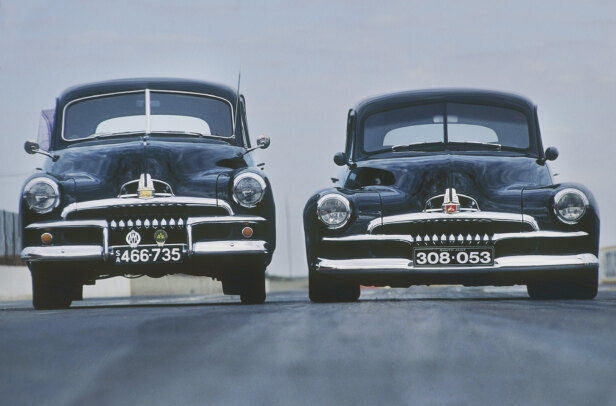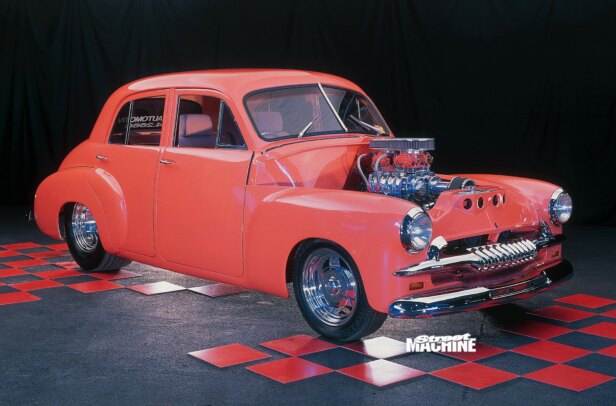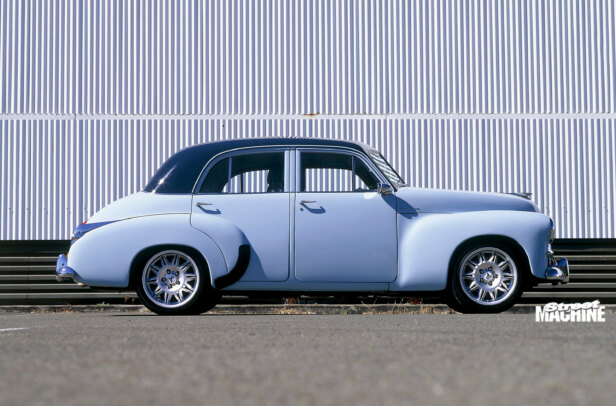First published in the February 2005 issue of Street Machine.
Clearly we’re looking at some serious drag hardware here. Tubular chassis, classic Humpy Holden body and a massive V8 poking its snout through the bonnet.
Well no. Despite first impressions, this bad-arse FJ packs three chambers of 20B Mazda rotary. So how come it looks like a hulking V8? Owner Garth Bell just wanted it that way.
The car has a long history on the street, the strip and around the shows, with several owners. Garth bought it in 1992, mounted on a Chev Luv chassis and carrying a 350 Chev, Powerglide, nine-inch and tilt front. The car had previously been Ford powered and appeared in the September 1989 mag when owned by Dave Hemsworth as pictured below.

“I tidied it, freshened the engine, and ran it in Super Street at Eastern Creek, rattling off an 11.3 at 119mph,” recalls Garth. “It didn’t have a rollcage so ANDRA wanted me to slow down. Stuff that! — I got onto Rod Andrews. He reckoned the cage wasn’t compatible with the Chev chassis, so we began again.”
Rod regards the FJ as his first real job. “That car kicked things off,” he says. “Garth asked me to build the car for him, so with his deposit I purchased the necessary equipment and the project commenced. Mick West provided the welding and tin-work. Mick and I both had full-time jobs — we did this part-time.” Rod now does chassis full-time (Andrews Race Cars) and Mick is now Mick’s Metalcraft.
The result was a Humpy with a killer stance, left-hand drive conversion, lift off front, ‘glass doors and pumped rear guards.



Rod fitted the car with a Peter Ridgeway-supplied, TRE-built, Buick 351 Pro Stock engine and Powerglide, but with Garth’s business and family commitments growing, the car was sold to Wayne Abbott in 1995. However, one of the conditions of sale was that Garth had to be offered first dibs if Wayne chose to sell it.
“Wayne rang me up in 2002 and said he was starting a business — he wanted to know if I wanted to buy it back off him…” Garth explains.
He could have raced the FJ with the big-block Chev Wayne had put in it but watching the quad-rotor Mazdas at Le Mans gave him another idea. “The sound was incredible,” he reckons. “Like a V8 but fuller, and all coming from one pipe — just amazing. Initially, it was just a bit of a joke but the more I thought about it, the more I thought: ‘What the hell’.”
Surprisingly, Garth isn’t into rotaries in a big way. He played with a Mazda RX-2 in his native New Zealand in the late 70s but he had to do a lot of homework.
“I wanted supercharged, not turbocharged, to keep the old-school look. And running a blower means we don’t have to dick around on the start line — there’s boost from nowhere; it’s on the warpath as soon as the lights go green.”

Questions about a rotary into a Holden were met with laughter but a trail of internet sites across the world led Garth to Joe Signorelli’s Rotor Master operation in Sydney. Garth says: “Joe laughed the least. He wanted to have a go, and it evolved from there.”
Garth’s plan was to buy or build a quad-rotor engine like the Le Mans racers. Mazda rotaries come in 13B twin-rotor, or 20B triple-rotor form. Joe had plenty of experience with the triple rotor and for simplicity and cost it was decided to use a factory triple-rotor rather than attempt a fully-fabricated quad.
Rotary engine-building basics are the same as piston engines — make it breathe and keep it together.
“Ported, dowelled, balanced and lightened, with ceramic seals, and basically that’s it,” Signorelli sums up. His old Series VI Mazda RX-7 race car ran a 7.53 so when he talks, it’s worth listening. “I built it the same as a turbo engine, identical to my old race car.” That means factory 20B Cosmo rotor housings dowelled to the intermediate and end-plates to resist movement between them. “If the housings move, the apex seals fall out of their grooves,” explains Joe.

The eccentric shaft (a rotary’s crank) has been balanced and the rotors lightened. “We also did a bit of work to the oiling system to help the bearings and the porting. It’s what I call a Rotor Master race port. It’s forced induction — we’re yet to see, but I reckon it will behave the same as a turbo engine. There’s no difference really,” says Signorelli.
Running a blower means it’s on the warpath as soon as the lights go green
The job of creating the unique blower set-up landed with Mick’s Metalcraft, which built the manifolds (including a near-side support that looks like a V8’s tunnel ram), along with Jeff Ramsey Engineering, which set up the Mooneyham 6/71, teflon-tipped race blower’s drive belts and crank support. Garth is full of praise for both, and with the manifold and blower bulking-up the appearance of the diminutive rotary, it’s hard to disagree.
A Microtech management system and a set of Indy blue methanol injectors feed the engine from under a carbon-fibre Ballistic intake, and four exhaust stubs poke out from under the off-side front guard. Steve at Rotor Master added a dummy pipe to make the car look normal: the triple-rotor needs just three exhaust ports.
Channelling a hoped-for 1000hp to the rear end is a two-speed Powerglide, supplied by Steve Butchart of BMS Products in Narrabeen. Behind it is a Mark Williams nine-inch rear end, swinging from a four-link, coil-over suspension system. The shafts are 40-spline and gun-drilled, with a 4.56 gear-set between them. The front suspension is also coils — struts — and brakes are a mix of Wilwood and JFZ discs. The rear wheels are 15×15 Australian-made Max Wheel Beadlocks with Hoosier rubber, while the fronts are Dragway’s new DB50s with M&H front runners.


The old Humpy shell has been modified so much it wouldn’t recognise itself, especially in its dinner-suit paint. Found on Honda’s colour charts, it looks black in most light conditions but is in fact blue. It was applied by Bonnyrigg Smash Repairs.
Garth’s hoping for high eights when the car runs in early 2005. Then the experimentation with tune and boost levels begins. Like it or not, a Humpy Holden with a supercharged rotary in a comp car is attention-grabbing innovation.
The engine in detail:
- – At the top of the tree is a carbon fibre injector hat, bolted to a spacer plate. The first of three banks of fuel injectors squirts methanol into the right-hand side of the spacer.
- – A 6/71 Mooneyham blower provides the visual appeal lacking in most rotaries. Garth isn’t the first Aussie to have tried this kind of combination — check out SM, Jan-Feb 1991, for Bill Nabhan’s 3/71-blown 13B RX-3
- – Rotary engines have their inlet and exhaust ports on the right-hand side of the engine, meaning this, the left-hand side of the inlet manifold is a dummy. It not only provides a symmetrical look, but also the strength needed to hold the blower up firmly in the breeze
- – The second row of fuel injectors squirts into the intake manifold runners, while the third set fits straight into the block
- – Yep, that drum-shaped thing is the engine itself, waaaay down there! Makes for a really long blower belt
GARTH BELL
1954 FJ HOLDEN UTE
Colour: Honda Dark Pearl Blue
| POWER | |
| Engine: | Mazda 20B triple rotor |
| Blower: | Mooneyham 6/71 |
| Heads: | Don’t think so |
| Cam: | Nope |
| Valves: | Can’t find ’em. But it has Rotor Master porting |
| Valve springs: | There’s no valves, so… |
| Pistons: | Um, balanced and lightened rotors with ceramic seals |
| Crank: | There’s a balanced eccentric shaft |
| Manifold: | Mick’s Metal Craft, alloy |
| Management: | Microtech |
| Boost: | 15psi intially, up to 30psi later |
| Exhaust: | Rotor Master zoomies |
| SHIFT | |
| Gearbox: | Two-speed Powerglide |
| Converter: | 3500rpm |
| Tailshaft: | Thick-wall custom |
| Diff: | Mark Williams nine-inch, 4.56:1 |
| UNDERNEATH | |
| Suspension: | Strut (f); four-link, coil-over (r) |
| Brakes: | JFZ discs (f); Wilwood discs (r) |
| ROLLING STOCK | |
| Wheels: | Dragway DB50 (f); 15×15 Max Wheel Beadlocks (r) |
| Tyres: | M&H front runners(f); Hoosier slicks (r) |



Comments